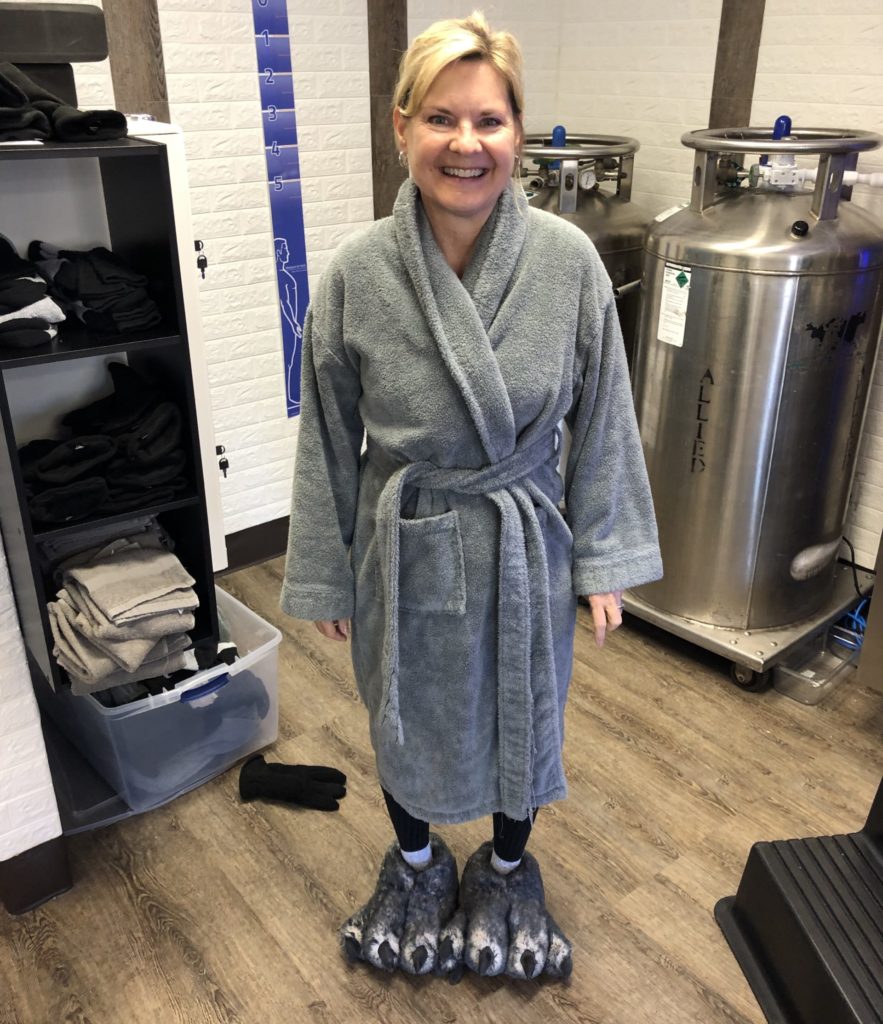
Judi Achore has no particular thoughts of abandoning the Valley’s scorching heat for someplace cooler. Besides, she learned recently, Greenland is not for sale.
Yet she willingly endures 3 minutes in a chamber chilled to 220 degrees below zero—twice as cold as dry ice and 10 times colder than a nasty day in the Upper Midwest—in her underwear.
Her curiosity about cryotherapy, which is growing in popularity among elite athletes wanting to recover more quickly from workouts, and among weekend warriors just wanting to feel better, drove her to a sci-fi-looking cryotherapy chamber.
“I wasn’t terrified, but concerned,” said Achore, 56, of West Chandler. “I was so curious. For 3 minutes I said, ‘Let’s do it.’ And I saw somebody do it. It helped a lot to see somebody else and to know that it’s only 3 minutes.”
In May, personal trainer Kevin Freeland, 55, also of West Chandler, opened Cryo Tempe, the first cryotherapy facility in the South Tempe-West Chandler-Ahwatukee area, as a side business within his gym. Freeland has operated Body Focus Fitness & Performance on Kyrene Road just north of Warner for 15 years.
Achore, who has trained with Freeland for years, was among the first to try it.
Freeland opens the door of the liquid-nitrogen- infused chamber and vapor rushes out. In steps Achore, a recreational tennis player.
Freeland, who holds a microbiology degree from the University of Arizona, agrees that it is helpful to watch a cryotherapy session before trying one.
“When you see somebody in there and they’re not screaming in terror or pain, then it’s not that bad,” he said. “When you sit down and go over the benefits of it, most are willing to at least give it a shot.
“And a lot of people come in actually looking for it. It’s growing. They’ve heard about it and we’re the only one in this part of town.”
Why cryotherapy?
A 2017 review of studies on athletes in the International Journal of Sports Medicine suggests that cryotherapy can be effective in reducing muscle pain, inflammation and cell damage. It’s like an ice bath on steroids.
Anecdotal evidence also suggests that cryotherapy can be effective in combating anxiety and depression, according to an October, 2017, report in Medical News Today.
There is growing evidence that cryotherapy is effective in weight loss.
Exposure to extreme cold also increases circulation and collagen production. Cryotherapy is not for everybody, say those in the know. It should be avoided by anyone with respiratory illness, history of heart attacks and stroke, high blood pressure, cardiovascular disease, Raynaud’s syndrome, metal implants or pacemakers and those younger than 18.
Cryotherapy is not yet regulated by the U.S. Food and Drug Administration, and most medical insurance is not yet onboard with it, either.
Freeland’s Cryo Innovations XR, made in Newport Beach, Calif., has a heart-oxygen monitor that clips to the ear lobe and is connected to a suite of biometric monitoring equipment mounted on the outside of the chamber.
Freeland constantly monitors the client’s numbers on a panel during a session.
Clients strip to their underwear and are given a robe in the dressing room.
They also are required to wear manufacturer- provided stockings, slippers and gloves to protect the extremities. The treatment is from the collarbone down.
The head is above the chamber and must be kept up because breathing nitrogen vapors can displace oxygen, and that can be dangerous. There is a head sensor, and an automatic shut off if levels become dangerous.
The chamber door also can be opened from inside if the client is uncomfortable.
“These are safety features that other machines just don’t have,” Freeland said.
It is cool at first, not chilly. Clients keep their feet, hands and torso moving gently as directed, like doing the Twist in slow-mo. Some report feeling a sting in the forearms and calves in the final 30-40 seconds.
Achore’s 3 minutes are up and she steps out with a smile on her face. It is not a frozen smile—she has nothing in common with Ted Williams. She is uplifted and energized. Her skin is red, a normal byproduct that disappears as the afternoon wears on.
“There’s such a feeling of well- being,” she said, “and then I found out there’s a collagen benefit for better skin. I just think the concept is very simple: 3 minutes in the cold and you have the benefits.”
Information: cryotempe.com, info@cryotempe.com, 602-849-5280.


